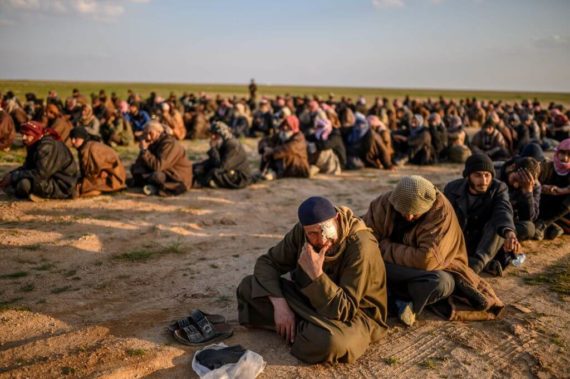In the two years since Kurdish forces wrested away the Islamic State’s last Syrian bastion, the jihadist group has proved it does not need a stronghold to pose a potent threat in more countries than ever.
At their apogee, the extremists controlled a territory the size of Britain covering large swaths of Syria and Iraq, where it waged one of the most brutal campaigns of systematic terror in modern history.
Its defeat on March 23, 2019, was, it turns out, far from definitive, with the group managing to maintain its cohesion despite the dispersal of its leadership.
It has also continued to claim scores of deadly attacks far beyond its original base, while taking advantage of the vast deserts of war-scarred Syria to target forces loyal to the regime of President Bashar Al-Assad.
“It has for the time being gone to ground, but with the goals of maintaining its insurgency in Iraq and Syria and a global cyber-presence,” General Kenneth McKenzie, head of the US Central Command that oversees troops deployed in Afghanistan, Iraq and Syria, said last month.
At the same time, the group is “building and retaining a cellular structure which allows it to carry out terrorist attacks,” he said.
Shortly afterwards, France requested a meeting of the coalition partners who teamed up with Kurdish forces to drive out the insurgency, warning of a “strong resurgence of Daesh,” an Arabic acronym for the group.
The worries are well founded, analysts say.
Between the fall of IS’ eastern Syria holdout of Baghouz and last month, the group has claimed responsibility for 5,665 military operations — an average of eight per day — according to a widely followed terrorism expert who publishes on Twitter as “Mister__Q_”.
And Syria and Iraq are still subjected to IS attacks, like the one when twin suicide bombers struck Baghdad in January, killing more than 30 people at a market.
– New goals? –
The group’s gruesome propaganda videos of prisoner beheadings, immolations and other atrocities, which drew scores of foreign fighters to its “caliphate,” have also resonated beyond the Middle East.
IS fighters are now active in 30 countries ranging from Egypt, Mali and Mozambique to the Caucasus and southeast Asia.
Even the death of its chief Abu Bakr al-Baghdadi during a raid by US forces in October 2019 had only a limited impact, with its new leader Mohammed Said Abd al-Rahman al-Mawla still able to direct and inspire attacks by its far-flung affiliates.
Al-Mawla’s aims may still be uncertain, but the deadly potential of the group’s decentralised command structure remains intact.
“Taking out ISIS leaders is still of value to the international coalition, particularly in terms of intelligence, but it’s not going to remove ISIS from the battlefield,” said Charles Lister, a counter-terrorism expert at the Middle East Institute.
And no matter where it operates, the tactics are the same. “First it exploits a state’s instability by hounding its armed forces in a kind of war of attrition,” the analyst known as Mister__Q_ told AFP.
“It then forces its rivals to flee the territory, and sets itself up as a guarantee of security for the local population,” he said.
The third phase of setting up an administrative “caliphate” comes later — though many analysts now believe the Islamic State does not actually want or need it.
“The idea that the caliphate ended when the international coalition re-took territory in Iraq and Syria is a Western conception mostly alien to ISIS itself, especially given its expansion internationally,” Lister said.
“In the minds of its members and supporters, it still exists today,” he said.
– ‘The caliph’ –
Tore Hamming, a researcher at the King’s College Department of War Studies in London, agreed that the Islamic State’s ability to quickly shift tactics poses a huge challenge to nations hoping to stop it from taking root.
“I don’t think the group would agree that the caliphate ended,” he said. “After all, their leader is still entitled ‘the caliph’.”
Looking ahead, officials warn that IS leaders will focus on recruiting the huge numbers of young people whose lives have been upended by the years of sectarian conflict in the Middle East and West Africa in particular.
The US estimates for example that 62,000 suspected relatives of IS fighters are held at the squalid al-Hol camp in Syria. Two-thirds of them are younger than 18 years old, and half under 12.
For them, the group’s notorious black flag could be a powerful magnet after a life steeped in misery, violence, religious fanaticism and hatred of the West.
“The longer-term risk is the systemic indoctrination of this population to ISIS’s ideology,” McKenzie said in February.
“Failing to address this now means ISIS will never be truly defeated,” he added.
AFP

